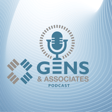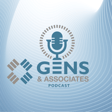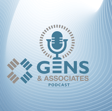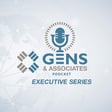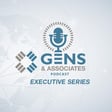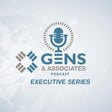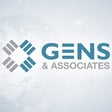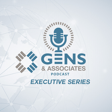Become a Creator today!Start creating today - Share your story with the world!
Start for free
00:00:00
00:00:01

Service Provider Series Episode #2 - Marty Boom and Tris Nockles (Navitas)
In today’s episode, Steve Gens is joined by Navitas’ Marty Boom (Global Head of Regulatory & Safety) and Tris Nockles (Regulatory Nets Lead) to discuss Navitas’ “nets” and leading consulting services, opportunities and innovation with AI/Automation in Regulatory, and a look into the future at Navitas!
Transcript
Introductions and Backgrounds
00:00:00
Speaker
Welcome to the Gens and Associates Regulatory Executive podcast series. This is Steve Gens, managing partner of Gens and Associates. And today we're talking with two key leaders from Novitas, Marty Boom and Trish Knuckles. So Marty and Trish, I've been looking forward to this conversation because when we look at our respective organizations, we both do very meaningful um you know benchmarks you know for our communities.
00:00:28
Speaker
So there's a lot of similarities that we have, although you know we kind of play in different areas. So before we get started, if you guys can do a brief introductions about yourself and Navitas the area that you represent for our listeners.
00:00:44
Speaker
Sure, Steve. and And I'll pick you up on that comment about we're doing similar activities. Navitas is a CRO. We are a full CRO ah business. And within that business, we have something that makes us really unique. And that's our networks. yeah And that will be one of the main topics today. The other thing that makes us and and unique is is the consulting branch. yeah And that's what we're going to talk about today yeah also.
00:01:12
Speaker
ah guess yeah so yeah there is ah There is definitely and and and a close relationship to Gens Associates and and our industry networks. Personally, I'm i' one of the founders of of these networks. PVNet was created 20 plus years ago. um and yeah that's I joined Naviels just a couple of years before that, but my my background is is actually industrial engineering. I'm an automation, manufacturing automation expert. Was, I should say, yeah a long time ago. And I've grown up in the business more in the management consulting and regulatory and safety side. So that's that's where I come from.
Synergy and Services of Navitas
00:01:55
Speaker
Tris is slightly different for me, yeah but plays a key role in our networks. Yeah, so interesting, of course. I look after the networks on the regulatory side for Navitas.
00:02:08
Speaker
Um, I've been with Navitas about four years now, so not nearly as long as, uh, Marty. Um, and I kind of have kind of drifted into where I am right now a little bit by accident. So, um, so before Navitas, I worked to at Johnson and Johnson for 18 years, um, started my career there in, uh, in IT t as a business analyst, then went into more of a kind of six Sigma process improvement role and then went into, uh,
00:02:37
Speaker
quality management, ah moving into the regulatory space and then um moving on to more of a kind of strategic project direction for the last five years I was there. um Actually, before ah J and&J, i I ran pubs and bars for a living. I don't have any science background at all. So um so sometimes if I look confused when the the net when the next members are talking to me about it' something very technical,
00:03:03
Speaker
because I haven't got a clue. and so so yeah So I have a ah completely different background to most of the people there but it's it's given me some good grounding in terms of facilitation and negotiation I would say in my past life. so Similar concern on my end Tris, I remember when people in drug safety started throwing adverse events at me and I was sitting there thinking like What are they talking about? But I learned over the years, I think I can claim a bit more scientific background now. Yeah, and maybe that's a good place to start because, again, with both firms doing benchmarks that I would say are followed, you know, and people look forward to those benchmarks, I know.
00:03:47
Speaker
I've learned so much about regulatory from my benchmarks and for our listeners, you know, Patricia and I, um you know, Alma Mater is Johnson and Johnson. I was a Janssenite or Janssenite, you know, way back in the 90s.
00:04:03
Speaker
When I hear Johnson & Johnson trash, it always brings a smile go to my yeah my face. It was such an informative time. But you know doing these benchmarks, you know we learn a lot. I mean, our clients learn, you know and I just see them as learning communities, your nets and you know what we do with our membership.
00:04:20
Speaker
But where I'd like to get started, and I think this is an understatement that over the last five to 10 years, there's just been such tremendous change in regulatory. We had talked here starting in 2013 that it's going to be the decade of regulatory modernization and then the broader.
00:04:38
Speaker
R and&D processes, you know which you guys also represent. So it's the process, it's the system layer for some companies, it's the operating model. um Now having your nets and you know certainly the consulting advisory services, you know you've done a lot of leadership. So could for our listeners, could you um you know go through or give some examples you know how Navitas has you know helped with this transformation in regulatory and the broader R&D Sure. So for people who don't know much about Navitas and what we do, Marty kind of gave a quick kind of overview that the nets have been around for more than 20 years now. um And we have a suite of networks within Navitas that we ah we we host them on behalf of the members, right? So they're our networks, but we but they're really the members, um the the members own them. So um we have ah networks in labeling,
00:05:39
Speaker
ah PV and also um regulatory information management. So those are our kind of sweet spots in terms of the networks that we run. um On top of that, we also have some round tables that are focusing around medical devices and also medical writing as well. So we're but kind of looking at the ah the the R and&D space in the in the round in that respect. We have a membership that spans large and mid-sized pharma companies.
00:06:08
Speaker
And we cover around 70 to 80 companies with about a hundred memberships in total. So some companies are ah members of um one or more of our networks. And I guess what we get told, and also, you know, I was a member of LabelNet before I joined Navitas. I used to attend the the forums.
00:06:28
Speaker
um And what we get told by the members is that it's a really unique experience. um um And we offer a number of different activities. um And that means that all of the colleagues within the companies have the opportunity to participate. So we want we run fighter we run forums twice yearly, and they are virtual um and also face-to-face for the senior leaders.
00:06:53
Speaker
um As you said, we do annual benchmarks. We do very comprehensive benchmarks, but we also do a number of ad hoc surveys as well, where members ask us to do that. We run a number of working groups. This year we've been focusing on digital labeling, um what we call target labeling, that early labeling development, and also devices and combination products. And we run something called the scientific community, which is really just a kind of random come in, drop in, ask any random questions that you've got. We get a lot of focus on reg intel and reg changes in that space. And then finally, um I think one of the things that is very unique about Navitas is we focus on the outputs. So we really try and make sure that we're giving good content back to the members. And we have a platform that we do that through where they can access any of the historic content from ah bygone years.
00:07:50
Speaker
So as I've said, the the activities are all member led, it's very collaborative and it's really nice when I stand in front of kind of 20 heads of labeling in New York and I don't actually talk that much anymore. They talk they you know they facilitate each other, they openly share and ask each other questions and they're they're just very curious and and very ah gracious in what they're prepared to share about what they're doing.
00:08:16
Speaker
um and And really we kind of just create the environment where they can interact and share their aspirations and challenges.
Consulting and Best Practices at Navitas
00:08:23
Speaker
And then we can kind of support them through facilitating that dialogue, best practices um and framework development. And also kind of giving them that content and outputs that they can use afterwards.
00:08:38
Speaker
I know you were asking me about the challenges. I'll come on to that in a second, but I just want to hand over to Marty just to talk a little bit about kind of the consulting team and and what we do over in the consulting world as well. Yeah, but's ah I think that's the interesting or fascinating part of the business. Within the nets so we create, to your words, Steve, yeah there's a lot of learning in there. and there's a lot There's a creation of best practices in there. There's this common understanding of affair where we're going with regulatory or with PVE.
00:09:08
Speaker
that that common understanding is there. What we do with the consulting team and with some clients is actually take all that learning and and implement that in the client's environment. as So the proper change ah projects. ah And personally, this is for me the fascinating part of the business. you and If you can really take learning and and drive a change in an organization,
00:09:32
Speaker
And it's it interesting to see how companies handle these these implementations. and There's always this this point of how far can you push the client? yeah and What you develop in these networks is is sort of an ambition. There's a goal and a good strive for, but it doesn't mean that every company is able to to implement that ambition. i you There's other factors coming into play, like the risk appetite that a company has, or it's just the timing of the change.
00:10:02
Speaker
yeah had the whole culture of the company and fascinatingly some clients you can push only to a certain limit and other clients are willing to go a lot further and actually go beyond that that learning that that comes out of our networks and that allows us to take that learning back again and feed it into the networks and and yeah lift the the experience of all the membership there to to another level.
00:10:29
Speaker
I think that that really is the the fascinating part of consulting and the interaction between net and consulting on the other side. yeah It really puts us and and the clients on the forefront of the latest trends and and thinking and making it happen in practice.
AI in Regulatory Processes: Challenges and Transformations
00:10:48
Speaker
Yeah, that that's great. And it's, so you know, it's a unique model that you guys have, um you know, and that we have, too, because I always say that our membership and people that participate in our benchmarks, it's a learning community. And if we go back 10 years ago, people would say operationally, well, this is competitive, ah you know, advantage, they have kind of their secret how they do their operation. Now, I think we're in such a period of ah sharing, the competition is in the science, right? But everything that companies do, they want to get more efficient, we're trying to be better, being global. And I see kind of what you guys do with your benchmarks and your nets, because anybody can do a benchmark. But it's brought to life through the membership and and that kind of learning that they're credible. I mean, both our organizations are credible guides. you know We use all this information.
00:11:40
Speaker
you know to guide guide our members and the broader industry you know with a lot of the ah know thought leadership. And it's good to hear because we do some similar things where if you have a community of experts from all these great companies on the planet, sometimes you co-create best practices or or common practices as I would like to you know say.
00:12:01
Speaker
So I'd like to ah shift to the big conversation of the the day, the AI automation. Some clients still get confused the difference between AI and automation, ah but that's starting to change. ah For this, I always follow the Gartner hype cycle, like how much of this is hype and how much is you know is going to be real, small incremental changes, where are going to be the transformational you know changes. And I think, as you guys know,
00:12:28
Speaker
um Just like you do your impromptu surveys, we have a pulse survey from the follow-up of our world-class RIM. You know, just again, the scope is regulatory about AI and automation taking a much deeper dive besides budgets and use cases, you know, to readiness views when certain technologies like gen AI for medical writing are going to break through.
00:12:50
Speaker
And also, we're merging, we have over 15 software providers, some of the, you know, the key players in our space. Others are all these niche players that are coming up, you know, especially the Gen AI ones. So that's going to be really interesting. And I'm sure that's a big conversation in your nets, you know, not only in the rimnet, the labeling, the PV safety. So how do you drive innovation for your clients? And it would be interesting kind of what you see you know out there from both a regulatory and a broader R and&D standpoint near and longer term about you know the impact of AI in automation.
00:13:30
Speaker
Yeah, so thanks for that question, Steve. I mean, I think you're absolutely right. You know, it's a burning topic for our members in the nets, definitely. um And actually has been for maybe the last um three to four years. But it's quite a difficult topic to talk about, actually. um So I think, you know, the first thing to do is to separate AI and automation, right? So there are, um you know, we'll talk about the the different ah use cases in a second, but there are probably more use cases right now so of that are working in automation through some of the laboring technologies that are available. um So, you know, it might be about using ah the the workflows that are within their RIM solutions. And so for some companies, they've also built their own um workflow tools or or ah business process management tools as well.
00:14:28
Speaker
So, you know, whilst kind of what we're seeing is that most of the changes are around machine learning or, or robotic process automation. um And the, the business cases are ah fairly straightforward, but where the larger cost reductions are coming through, that's a little bit harder to achieve really. So, um so if we talk about automation, for example, um we actually did some work maybe two years ago in, in RimNet.
00:14:57
Speaker
that was at the request of one of the founder members around looking at some of the generic use cases for automation within RIM. And that was really coming from a place of them not feeling very well-served with their um that particular technology at that point in time. um But actually, as we as we looked into that, we found that automation was fairly scant and scarce and very embryonic within RIM, regardless of which system you were using.
00:15:27
Speaker
So ah we landed on a kind of ah list of um of ah use cases. And our top three came out as ah data quality, which, of course, is critical for everything else that you ever want to do with with AI or downstream in your in your processes. and And data quality fell into the fix it or the stop it going wrong in the first place kind of categories.
00:15:53
Speaker
um product product registration management, that was the other one that came out high in terms of automated creation of the application. um And number three was planning and tracking and analytics, and that includes notifications. So in terms of automation within the rim space, there's some fairly easy kind of targets that the vendors could be ah supporting the the teams within that space.
00:16:19
Speaker
And then when we look at automation within label net, looking through the benchmark data, we see around 40 to 50% of the members currently taking advantage of things like automated workflow management and notifications. And then in the future, starting to focus on metrics management, automated QC and content creation. Kind of then thinking about some of the other automation cases that come up for for R and&D in particular,
00:16:49
Speaker
um A lot of companies looking at how can they automate their response to questions or the response to queries from the health authorities. So we know that they receive yeah every time you do and an application or a submission or um yeah any other kind of communication with the health authority, there are always questions coming back in and the management of those can be quite difficult and quite time consuming.
00:17:14
Speaker
So companies have been looking to find a way where they can kind of catalog those as they come in and tag them into certain categories um and then re-use the, you know, identify those queries as common when a new query comes in um and then be able to look at the responses in the past and um and generate some kind of response automatically. So I think um Up until now, it's been very much looking at it through the automation space. But I think now in that particular use case, you can start to really pair automation and AI together. Where if you had a number of responses that you've given back to a particular question historically, you can now start to use your AI to actually generate a suggested response that gives you a head start if nothing else.
00:18:07
Speaker
um But it also means that you're not giving go back to health authorities with conflicting responses as well. So I think it's yeah that's a really good use case in terms of um a space where ah companies are really looking to think about how can they pair both their automation and their AI together. Marty, maybe I'll i'll see if you've got anything. Yeah, I just wanted to add to that. Actually, yeah I think if you if you look at where the industry or every industry has been so far,
00:18:36
Speaker
Yeah, when you, when you, one of the first step that many companies take is is is outsourcing and you go into the BPO model. And and by doing that, you you you already reduce your costs significantly. Yeah. And now if you then look at what happens in the next step, which is the automation that Tris just described, automation is relatively inexpensive.
00:19:03
Speaker
yeah And that allows companies to do things, bearing in mind that if you've already taken a large part of your cost out, you're now trying to automate activities that are already lower cost. here So the potential savings that you're going to make are far less. But given that that's what the forms of automation are relatively straightforward. It's it's still There's still a good return on the investment. yeah and And we as a company, we also look into that for our services. yeah We automate more and more in that in that environment. Now, getting to the next part of adding AI to it, the first step that Trish just described, out that sort of preformed response that I think is is definitely ah very viable. But we see at the same time in in all the consulting projects, but but also in the discussions within the nets,
00:19:59
Speaker
We see the discussion really go towards, guys, what is the return on investment that we're going to make here? How much do I need to invest in in AI to get it to a point that it's good, yeah that it's trustworthy, that it is compliant, yeah that the answers are conformed, what you would expect. ah yeah And that investment is actually very, very high. yeah And the return that you're going to get on that, yeah bearing in mind that the pool of ah of cost is has gone smaller.
00:20:28
Speaker
It's a very, very difficult business case. That's that's where we see the big struggle in in the industry. Yeah, I would agree. And I think um yeah you know companies are trying to figure out what the best and most viable use cases are. And I think you know with AI, we see a lot of um a lot of potential in terms of being to go out and and look kind of more broadly at the environment more easily. so you know An example might be that at the moment, you know we're we have tools that are being developed by some companies to look at both reg intel and labeling intel internally. So really going out and scraping kind of the information that's publicly available and bringing that back in to to then inform their labeling or their approach to how they're going to implement a regulation.
00:21:23
Speaker
um So looking at alternative solutions for doing some of those things that typically they're using vendor solutions for right now and might be able to either develop internally or or um source more cheaply using some of the AI technologies.
00:21:40
Speaker
Yeah, I do have high expectations from journey I by the way, that I think has a better chances than than the AI that we are going through at the moment, I see a more difficult implementation. Yeah, yeah um Marty I couldn't agree with you while you know more because this I mean we could spend an hour top, you know, talking on this topic.
00:21:58
Speaker
So, but, you know, as you say, we see this through our membership and our, because we track this very closely in our benchmarks that the good news is there's so much experimentation going on, a lot of proof of concepts. And some of our clients are being really, really smart about like their digital strategy for regulatory. It's not like when we're going to implement, you know, generative AI for medical writing, the CSR, everybody's working on the CSR.
00:22:24
Speaker
but when they believe um the accuracy will be at the point where they can deploy it. So that's some of the stuff kind of that breakthrough that we're trying to get out of the you know the survey. you know The other thing that's interesting and just kind of reflecting on your guys' conversation is you know kind of what's the value. I mean, automation has been around forever. you know It just has different you know names and there's incremental you know kind of improvement.
00:22:49
Speaker
You know, but what really is, you know, AI, because there's, and we have a sentiment question in our survey from, hey, it's a virtual assistant, so it's going to replace a lot of junior jobs. And whereas really via sentiment and kind of in our our stance that it's it's more of an augmentation, like the virtual assistant, you know, a medical writer starts on version two, because the machine does version one.
00:23:13
Speaker
you know, of the, the CER, certainly Reg Intel. We've been tracking these use cases and just the one that you mentioned about the health authority questions and answers. That's, that's not like the beautiful combination of both automation, maybe for the ingestion process, right? And then AI for the mining of it and going through, you know, hundreds of responses, you know, based maybe that GRL can only look at, you know, 20.
00:23:39
Speaker
So we are kind of we kind of recommend thinking about it as a virtual assistant. um ah One thing earlier this year, we did an ad promo pulse study and collaborated on that with ah you know another group. And they just happened to be at a DIA show that was just for ad promo. And um they asked you know ask for a raise of hands, you know who's starting to plan and trying to do some work with AI automation for ad promo. And everybody in the audience you know raised their hands.
00:24:13
Speaker
Who has something in um implemented in production? All the hands went down. So I think it's just we're in the golden age of experimentation and following that Gartner hype curve. This is what happens. There's a lot of proof of concept, some kind of fall off the vine and others. And I completely agree with you because we've been tracking Greg and I, the structure content authoring, kind of the reuse paradigm versus generative AI. And I think it's going to take a little bit longer than what people want. But I think there's going to be a major breakthrough.
00:24:43
Speaker
there with the generative AI, it's just crazy what this technology, you know, can do.
Collaboration and Future of AI at Navitas
00:24:48
Speaker
So, um, that some just maybe just one thing, Steve, I think, you you know, just as a, as a thought in terms of companies that are starting to explore this is, ah you know, one thing that I would say is this is such a great space to collaborate in, right? Because something that might be happening somewhere else in your organization might be, ah might be a parallel kind of use case that you can use in your organization. So I think it's a really good time for companies to be collaborating much more, both internally and externally. I'm really uncovering what other people are doing to see and and get open to, Hey, that could be used in my, ah my part of the organization if I just repurpose it in this particular way. So, you know, so I think it's a really exciting time for companies to be talking to each other as well.
00:25:41
Speaker
ah greetris And this is where we're going with the with the company. yeah Also, if I look at our services side of the business, it's it's very much around partnering with other companies. Yeah. See how we can push the latest technologies, AI. We have small steps in GenAI. How can we push that to to our clients? and And that collaboration also gives you a chance to build up a bit of volume. yeah Keep in mind that you know this is quite highly specialized.
00:26:10
Speaker
areas that we work in and and and volume doesn't come in in in large quantities. yeah that's so that yeah There is a mass needed for everything. yeah And I think that's where we are going with the company most definitely i still is partnering and how can we with our partners can we make our services better and and share more of the yeah of the latest technologies with our clients.
00:26:35
Speaker
yeah Yeah, and and both of you, you transitioned beautifully to the last question I had and is, what should industry expect from Navitas, both the nets in the regulatory services in the coming years? And and Trish, youre your comment about with AI automation, it's such an opportunity, again, getting back to a lot of companies are sharing you know kind of you know operational practices. and Certainly, you know, the nets, you know, what we do of our membership, they're they're great collaborating, you know, kind of networks, it's all about learning, right? So yeah, if each of you, as we kind of finish off here, what can we expect from ah Navitas in the near term? Well, let me finish on the services that you had, and you can wrap it up with nets. No, I think on the services side, like I said, it's it's all around the
00:27:29
Speaker
creating different engagement models for our clients. yeah yeah we We know that large companies is a different story about these smaller mid-sized companies so um making the investments in in in new technologies is a big hurdle and not so much from a financial perspective, but probably even more from an internal capability perspective. And what we are looking at is is is ah different engagement models in which we can can provide more more of our services utilizing the technologies and avoiding for clients to avoid them having to invest in in in new technologies. and thats That's very much where we're going with our services side. It's making things available for for smaller mid-sized companies.
00:28:22
Speaker
yeah and And on the nets, it's a little bit of kind of, we're going to continue the dialogue on AI and automation and technology, which kind of continues to be a pain point, honestly. So continue that conversation.
00:28:37
Speaker
um we Marty highlighted at the beginning that the nets is 20 plus years old. We did a cross nets event, I think maybe 10 years ago now.
00:28:48
Speaker
ah We're going to look at another ah crossnets event in 2026 and also build in more crossnets thinking. So what are those areas that are actually touching all of our networks similarly and how we can, how can we help them collaborate across the breakdown, some of those functional silos kind of thing around medical devices and around thinking about how do we build patient personalization and the patient perspective into what we do.
00:29:15
Speaker
We have Nuenets Navigator being launched in January, very happy about that. And we're going to be revamping our RimNet offering as well. So so for people who are looking at Rim, also you know outside of what you do with the Benchmark, Steve, feel free to come talk to us. um and um yeah And also testing to see if there's more of an appetite for more face-to-face interaction as well. So we kind of cut that back.
00:29:41
Speaker
um following COVID and went to two forums a year face to face, looking to see if there's an opportunity to do more localized roundtables, um particularly with the senior leaders. So that's kind of what we're looking at in the in the nets as well. ah Fantastic. And it's so good to be getting back to face to face of its workshop or your nets, you know, well, we do our design sessions before a large, you know, regulatory study and you know, and the last round. So in the the fall last year, you know, it's always the odd year in the fall before we do the even year with the big world classroom study. Just to get everybody in a room again for a day, we had six of those. We go out to dinner, you know, break bread and have a meal, you know, you know together the night ah before. It's just it's so great to be back in person.
00:30:32
Speaker
So with that, um thanks so much. And maybe some of our listeners want to get a hold of you um and learn more about the nets in
Contact Information and Closing Remarks
00:30:41
Speaker
Navitas. Certainly, I have recommended some of my clients to your label and safety net over the year. I know they're very valuable. So what's the best way for our listeners to get a hold of you? Different ways, ah Steve, in the usual and website here, NavitasLivesciences.com, LinkedIn.
00:31:01
Speaker
um can always reach out directly ah to Trish myself. Yeah, it's very very easy to find me on LinkedIn, there's only one for me. LinkedIn is a good channel. Yeah, so yeah please reach out, um or as Marty was saying through the website as well, we have a kind of contact us um form on the website that we that we follow very actively. um And also there's more information on each of the networks on the on the website as well. So please ah feel free to go have a look at that.
00:31:35
Speaker
All right, excellent. And for our listeners, certainly any questions here, just go through our website off the contact sheet or just like Marty and Trish. We're on LinkedIn every day, just reach out. I think there's only one, Steve Gens too, Trish. We're lucky now having unique you know unique names. Yes. so um So thank you so much you know for your time. I really enjoyed the ah the conversation today. So thank you. Thank you, Steve. Thank you very much.
